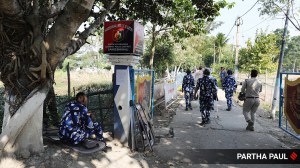- India
- International
Maharashtra revises township rules, unlocks more green land for construction
On Tuesday, the Chief Minister-led Urban Development department notified revised regulations for integrated township, where the developers will now be permitted to exploit anywhere between 3-3.6 times the existing building rights on green belts, depending on the size of the township.
 The government has justified the move, contending that the revision “needed to meet the growing housing demand.” The department has argued that “increasing construction rights on green belts contained in a township would lessen the demand for diversion of more agricultural lands for construction purposes.” (Representational Image)
The government has justified the move, contending that the revision “needed to meet the growing housing demand.” The department has argued that “increasing construction rights on green belts contained in a township would lessen the demand for diversion of more agricultural lands for construction purposes.” (Representational Image)
Thousands of new homes could come up on Maharashtra’s green belts with Chief Minister Devendra Fadnavis incentivising development of townships on these parcels.
On Tuesday, the Chief Minister-led Urban Development department notified revised regulations for integrated township, where the developers will now be permitted to exploit anywhere between 3-3.6 times the existing building rights on green belts, depending on the size of the township.
In February this year, the department had proposed the draft modifications to the pertaining regulations. These were finalised on Tuesday. Green belts were previously characterised by restricted construction activity. Maharashtra permits developers to set up townships on a composite plot of 40 hectares or more.
The government has justified the move, contending that the revision “needed to meet the growing housing demand.” The department has argued that “increasing construction rights on green belts contained in a township would lessen the demand for diversion of more agricultural lands for construction purposes.”
In the final rules, the government has made some additional modifications, most of which will end up sweetening the deal further for the township developers. For instance, it has withdrawn the rider that 2 per cent of built-up amenity space should be handed over free-of-cost to the local body. Sources said that a top business house, which wants to develop land parcels it owns in Navi Mumbai, will be the immediate beneficiary from the move.

It has also increased the extent of money the township developer can raise through sale of housing for economically weaker and low income segment. About 20 per cent of the residential buildable area in the township has to be put to use for social housing. The township developer has also been permitted to raise contributions from investors in the project to fund the project’s cost.
But it has clarified that the townships won’t be permitted on land designated as notified forests, water bodies, national parks, defence estates, cantonment lands, and eco-sensitive belts. It has, however, newly permitted that developments to be undertaken on tribal lands, and buffer zones of eco-sensitive belts, while restricting the development to the FSI permissible for such plots, and imposing a condition that a prior permission from the relevant authorities will be required.
Under the prevalent norms, a floor space index (FSI) of built-up area to total plot area of 1.7 is permitted for townships in residential or urbanised zones, whereas the FSI on green belts is restricted to 0.6. But the revised norms have done away with this distinction. Depending on the size of the township, the new norms allow developers to build up to 2.2 times the plot size in any zone.
Official statistics reveal about 31 out of 33 township projects approved have came up on green belts. None of these has been granted occupation certificate so far, while 17 have gone into construction. According to official information, the Pune region has the highest number of approved projects (20), followed by the Mumbai Metropolitan Region-Konkan belt (8), and Nagpur (5).
As per the revised norms, a township developer is entitled to a basic FSI of 1. For townships on green belts, no development zones, agricultural zones, lands marked as afforestation zones or hill slopes, a developer will have to pay an additional premium of 8-15 per cent of the agricultural land rate for the plot for zone conversion to residential use. Besides this, depending on the township’s size, a developer is entitled to a further additional FSI of 0.7 to 1 by paying another 10 per cent premium on ready reckoner rates. The state has also retained the existing provision of providing another 0.2 FSI to developers for meeting the obligation of building homes for economically weaker and low-income segments on 20 per cent of the buildable space.
Apr 25: Latest News
- 01
- 02
- 03
- 04
- 05






























